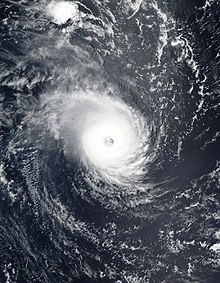
Back إعصار فريدي Arabic Cicló Freddy Catalan Zyklon Freddy German Ciclón Freddy Spanish چرخند فردی Persian Cyclone Freddy French चक्रवात फ्रेडी Hindi 사이클론 프레디 Korean Siklon Freddy Malay Freddy (cycloon) Dutch
 Freddy at its peak intensity while northeast of Rodrigues on 19 February | |
| Meteorological history | |
|---|---|
| Formed | 4 February 2023 |
| Dissipated | 14 March 2023 |
| Duration | 5 weeks and 3 days (Longest-lasting tropical system on record) |
| Very intense tropical cyclone | |
| 10-minute sustained (MFR) | |
| Highest winds | 230 km/h (145 mph) |
| Lowest pressure | 927 hPa (mbar); 27.37 inHg |
| Category 5-equivalent tropical cyclone | |
| 1-minute sustained (SSHWS/JTWC) | |
| Highest winds | 260 km/h (160 mph) |
| Lowest pressure | 923 hPa (mbar); 27.26 inHg |
| Overall effects | |
| Fatalities | 1,434 (Second-deadliest tropical cyclone in the South-West Indian Ocean, third-deadliest in the Southern Hemisphere) |
| Injuries | 2,004 |
| Missing | 19 |
| Damage | $1.53 billion (2023 USD) (Third-costliest cyclone in the South-West Indian Ocean basin) |
| Areas affected |
|
| IBTrACS: 1, 2 | |
Part of the 2022–23 Australian region and South-West Indian Ocean cyclone seasons | |
| History • Meteorological history Response • Commons: Freddy images | |
Very Intense Tropical Cyclone Freddy, also known as Severe Tropical Cyclone Freddy, was an exceptionally long-lived, powerful, and deadly tropical cyclone that traversed the southern Indian Ocean for more than five weeks in February and March 2023.[1] Freddy was the longest-lasting tropical cyclone ever recorded worldwide, and produced the most accumulated cyclone energy—a metric used to measure the total energy generated by tropical cyclones—of any individual cyclone on record globally.[2] Additionally, it is the third-deadliest tropical cyclone recorded in the Southern Hemisphere, only behind 2019's Cyclone Idai and the 1973 Flores cyclone.[3]
Freddy originated from a tropical low that was located south of the Indonesian archipelago on 4 February 2023.[4] As it traveled westward across the Indian Ocean, the storm quickly intensified, becoming a Category 4 severe tropical cyclone on the Australian scale.[4] Freddy moved into the South-West Indian Ocean, where it reached its peak intensity with 10-minute sustained winds of 230 km/h (145 mph) and a central atmospheric pressure of 927 hPa (27.37 inHg), making it a very intense tropical cyclone.[5] Meanwhile, 1-minute sustained winds reached 260 km/h (160 mph), corresponding to Category 5-equivalent intensity on the Saffir–Simpson scale.[6] After reaching its peak intensity, the cyclone moved toward the northern Mascarene Islands and made landfall near Mananjary, Madagascar on 21 February. It weakened further across Madagascar but regained strength upon reaching the Mozambique Channel, where it intensified and made its second landfall near Vilankulos, Mozambique on 24 February.[5] After moving across Mozambique, the cyclone endured and re-entered the channel on 1 March. It then regained its tropical characteristics and started moving along the coast of Madagascar. Freddy intensified again before making its final landfall near Quelimane, Mozambique on 11 March. It then rapidly weakened as it moved inland and dissipated by 14 March.[5]
Preparations for the storm in the Mascarene Islands included flight groundings, cyclone alerts, and personnel being prepped for the aftermath, among other things. In Madagascar, areas previously affected by Cyclones Batsirai and Cheneso were feared to be worsened by the storm's arrival. Impacts in Mozambique were more severe than in Madagascar and included heavy rainfall in the southern half of the country and widely damaged infrastructure. Effects in Mozambique were exacerbated after its second landfall with further floods and wind damage. The hardest-hit was Malawi where incessant rains caused catastrophic flash floods, especially Blantyre. The nation's power grid was crippled, with its hydroelectric dam rendered inoperable. Overall, the cyclone resulted in at least 1,434 fatalities, 2,004 injuries, 19 people missing, and caused about US$1.53 billion in damage.[7] Consequently, due to the extensive damage and loss of life, the Australian Bureau of Meteorology has retired the name Freddy from the Australian rotating naming lists, and a replacement name has yet to be announced.[8][9]
- ^ Cite error: The named reference
:Records (2)was invoked but never defined (see the help page). - ^ Cite error: The named reference
:Records (1)was invoked but never defined (see the help page). - ^ Masters, Jeff (5 May 2023). "Five of Africa's top 30 deadliest weather disasters have occurred since 2022 » Yale Climate Connections". Yale Climate Connections. Retrieved 10 August 2024.
- ^ a b Cite error: The named reference
TCR 2was invoked but never defined (see the help page). - ^ a b c Cite error: The named reference
:Freddy (Best track)was invoked but never defined (see the help page). - ^ Cite error: The named reference
:Freddy (cat 5)was invoked but never defined (see the help page). - ^ Cite error: The named reference
GFDRRDamagewas invoked but never defined (see the help page). - ^ Cite error: The named reference
Namewas invoked but never defined (see the help page). - ^ Wulfeck, Andrew (10 July 2024). "Ferocious Freddy: Meet the longest-lived tropical cyclone in history". FOX Weather. Retrieved 10 August 2024.